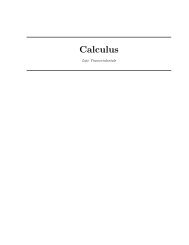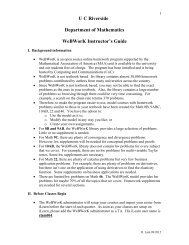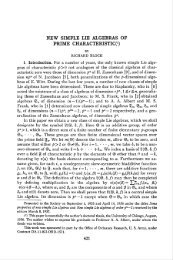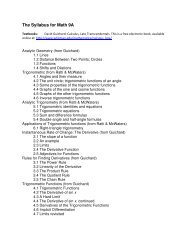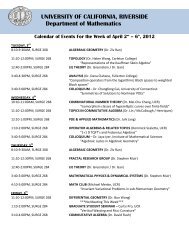Mining Big Data - Department of Mathematics - University of ...
Mining Big Data - Department of Mathematics - University of ...
Mining Big Data - Department of Mathematics - University of ...
You also want an ePaper? Increase the reach of your titles
YUMPU automatically turns print PDFs into web optimized ePapers that Google loves.
How did youget startedwritingpoems?My mother alwaysplayed with words withme. My home libraryreally was sayings,stories, riddles and somejokes, but not like ha-hajokes, just kind <strong>of</strong> funny. That’s a greatway to get the verbal mind nourished. Mychildhood was filled with verbal rhyminggames.The TomásRiveraEndowedChair inCreativeWritingbrought youto UCR in2005. Whathas the chairmeant toyou?It’s like opening adoor as big as the sky.Before I got here, theTomás Rivera committeehad been working for18 years to promotethe legacy <strong>of</strong> TomásRivera as a writer, as athinker, as a chancellor,as a pioneer in the artsand in education, as anessayist, a storyteller, apoet, a novelist. It startedthe year after he died.The group, under theleadership <strong>of</strong> ConchaRivera, his wife, brought in a number<strong>of</strong> well-known speakers on a variety <strong>of</strong>topics, and a lot <strong>of</strong> people donated to theendowment.What has thechair allowedyou to do?The chair has allowedme to be more mobile.I’ve visited a lot <strong>of</strong>schools, cultural and artmuseums and galleries,working with them to put together anumber <strong>of</strong> things, including the studentVerbal Coliseum show with bleachersdowntown at UCRARTSblock, in this casein conjunction with Shane Shukis fromthe Sweeney Art Gallery. There’s a littlemoney for travel, so I also visit libraries,tiny libraries like Highgrove, and speakat elementary school assemblies. In theeyes <strong>of</strong> the schools, the chair ushers me in.It means something to them to have theTomás Rivera Chair at their school.Has the chairaffected yourscholarship?It’s allowed meto bring innovativewriters to campus. Andit’s allowed me to travelto El Paso the last twoyears on a very amazing project. I thinkthere is a lost decade <strong>of</strong> Latino literaryand performance history from Juarez andEl Paso that was like the Harlem Renaissance.In the 1930s, Juarez and El Pasowere like rockets. There was radio, therewas poetry, there was dance, there weresongs, there was theater, and there wascircus and jazz and visiting artists fromthe United States and Mexico City, all inthat little borderland.This periodhasn’t beendocumented?No. Perhaps it wasperceived as a wild andred light and low-classand speak-easy world.The cabarets closeddown in the mid-’30s because <strong>of</strong> Prohibition.By 1942, the era was over because<strong>of</strong> the war. There was documentation, butit was at the household level, the familylevel. My uncle was part <strong>of</strong> that ’30scadre <strong>of</strong> artists, and I had some photographs.He was in a radio show in Juarezcalled “El Barco del Illusión” (the ship <strong>of</strong>illusion). It was a radio play with comedyand music. His radio partner was this guynamed Germán Valdez, who became aninternationally known comedian calledTin-Tan. Tin-Tan popularized the zootsuit in Mexico and Latin America. I knewabout Tin-Tan because my uncle workedwith him. I knew about the radio show.But that was about it: a floating squarein a blank checkerboard without anysquares in it. But then someone called mefrom El Paso and said, ‘I understand youknow about “El Barco del Illusión.”’ Theyasked, ‘Do you have any photographs?Because our mother who is going to be 92was a singer for that show.’ I’ve gone tointerview her for the last two years. WhatI discovered then was this lost decade.Are thereany taperecordings<strong>of</strong> the radioprograms?What will dowith yourresearch?I am looking for those.I want to remount theradio show as a musicalso we can see the actorsand see the songs. I’mreally excited aboutit. And it turns out that Cuca Aguirre,the women I interviewed, has a sister inRiverside, Eva Amezcua, who was also onthe radio program. She’s 96. They bothstill sing and recite poetry. They joined thiswhole renaissance in their teens.How wouldyou describeyour UCRstudents?The students hereare amazing. Thewriters, whether undergraduateor graduate,are charting newground. For a writingor poetry pr<strong>of</strong>essor, it’s exciting becausethey are really charging ahead. I say,‘Wow, I wish I was at the level they arewhen I was an undergraduate.’ Some <strong>of</strong>them I wish I was just at their level now!They have different cultural experiencesand languages and they are talented, verytalented. You walk into a creative writingclass and you are not going to see onestyle <strong>of</strong> creative writing. You are not goingto see one style <strong>of</strong> writing poems. They’reall charting-new-ground styles. It waslike me when I first started writing, eventhough they’re better than me. I startedwriting whatever I could, with whatever Icould and any way that I could. And thenlater, 20 years later, I picked up books andtools to shape and work the poem andread and talk about the poem. But first itwas just lighting the fire <strong>of</strong> poetry. That’swhat students are doing here. They arelighting the fire <strong>of</strong> poetry.To view videos <strong>of</strong> Juan Felipe Herrera,visit bit.ly/GSBU2aUCR Spring 2012 | 15



